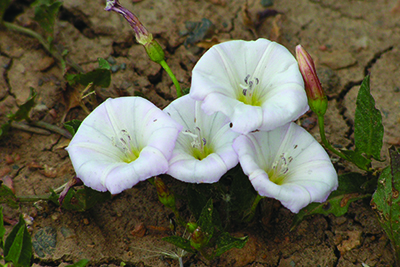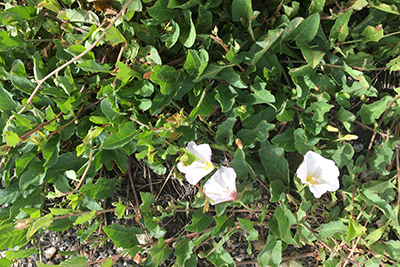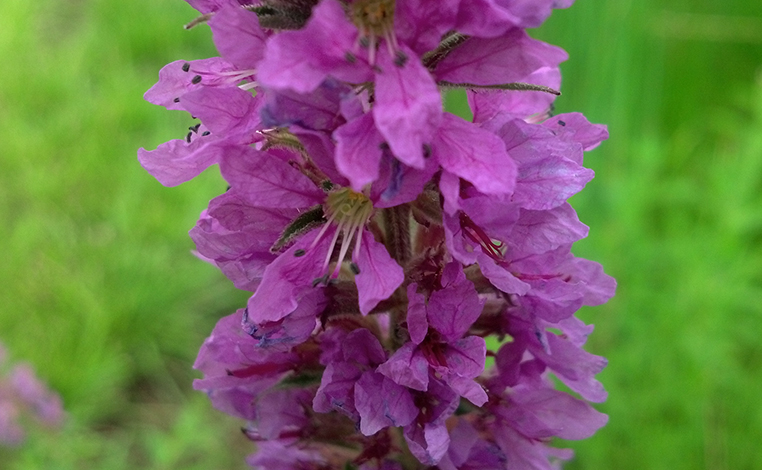Field bindweed
Convolvulus arvensis
Keys to Identification
-
Arrowhead-shaped leaves
-
White to pink funnel-shaped flowers with two small bracts one inch below the flower base
Family
Convolvulaceae – Bindweed aka Morning Glory Family
Other Names
Creeping jenny, European bindweed, Perennial morning glory, Small flowered morning glory, Field bindweed
USDA Code
COAR4
Legal Status
Colorado Noxious Weed List C
Identification
Lifecycle
Perennial
Growth form
Forb
Flower
Flowers are bell or trumpet shaped, with 5 fused petals, white to pink, about 1 inch long
Seeds/Fruit
Round, smooth ¼ inch cone-shaped capsule with 1-4 seeds in each. About 550 seeds per plant. May stay viable in the soil for 20-50 years
Leaves
Mature plants have arrowhead-shaped 1/2 to 2 inches long leaves Mature leaves at the base of the stem are larger than the young leaves at the stem terminal
Stems
Prostrate (grows low to the ground) twining, and grow up to 6 feet long
Roots
Taproot up to 10 feet long, extensive deep vertical and shallow lateral roots. Rhizomes. Vertical roots 20+ feet deep; 70% of the total root mass occupies the top 2 feet of soil. Most lateral roots are no deeper than 1 foot. Studies have shown that bindweed root and rhizome growth can reach 2 1/2-5 tons per acre
Seedling
Seed leaves (cotyledons) are nearly square with a shallow notch at the tip. Plants that arise from rhizomes (underground stems) lack these seed leaves
Similar Species
Exotics
Morning-glory – Ipomea spp
Hedge Bindweed – Calystegia speium
Natives
Wild Buckwheat – Polygonum convolvulus
Impacts
Agricultural
One of the most persistent and difficult-to-control weeds in landscapes and agricultural crops. It’s extensive root and rhizome system that makes it almost impossible to control with cultivation because it often spreads the infestation. Rhizomes are able to grow through fabric, plastic, and other barriers. It is very drought tolerant and once established is difficult to control even with herbicides
Ecological
Human
Persistent perennial development, combined with root fragmentation causes significant financial and productivity concerns in home gardens, yards and landscape areas
Habitat and Distribution
General requirements
Found in disturbed sites, pastures, rights-of-way, agricultural lands, orchards, vineyards, lawns and gardens
Distribution
Throughout the US, less prevalent in the southeast
Historical
Introduced to North America from Eurasia as an ornamental and for medicinal purposes in the mid-1700″s
Biology/Ecology
Life cycle
Perennial
Mode of reproduction
Seed and vegetatively. Extensive roots as deep as 14 feet and rhizomes can grow new plants from buds and when fragmented. This extensive underground network allows for overwintering without foliage, and it can persist for many years in the soil
Seed production
Mature plants can produce up to 500 seeds per plant
Seed bank
Seed may last in the soil for 20-50 years
Dispersal
Dispersed by animals, birds, equipment, seed contaminants and humans
References
Authors: S. D. Wright, UC Cooperative Extension, Tulare/Kings Co.; C. L. Elmore, Plant Sciences emeritus, UC Davis; and D. W. Cudney, Botany and Plant Sciences emeritus, UC Riverside. Produced by UC Statewide IPM Program, University of California, Davis, CA 95616
Colorado Department of Agriculture. 2020. Field Bindweed fact sheet. – https://www.colorado.gov/pacific/agconservation/field-bindweed
Integrated Taxonomic Information System. – http://www.itis.gov
USDA-USFS Fire Effects Information System (FEIS). “Convolvulus arvensis”. – https://www.feis-crs.org/feis/
PLANTS Database – https://plants.sc.egov.usda.gov/core/profile?symbol=COAR4
High Plains Integrated Pest Management – https://wiki.bugwood.org/HPIPM:Field_bindweed




